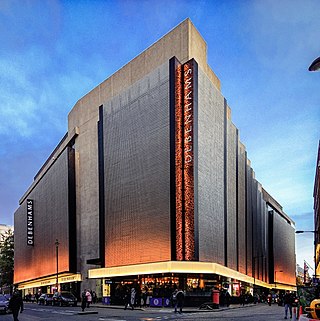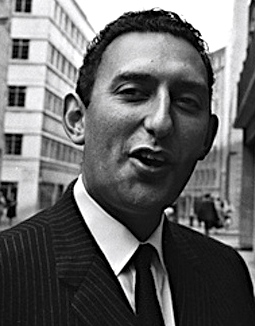Related Research Articles

Debenhams plc was a British department store chain operating in the United Kingdom, Denmark and the Republic of Ireland. It was founded in 1778 as a single store in London and grew to 178 locations across those countries, also owning the Danish department store chain Magasin du Nord. In its final years, its headquarters were within the premises of its flagship store in Oxford Street, London. The range of goods sold included middle-to-high-end clothing, beauty, household items, and furniture.

British Home Stores, commonly abbreviated to BHS and latterly legally styled BHS Ltd, was a British department store chain, primarily selling clothing and household items. In its later years, the company began to expand into furniture, electronics, entertainment, convenience groceries and fragrance and beauty products.

GUS plc was a FTSE 100 retailing, manufacturing and financial conglomerate based in the United Kingdom. GUS was an abbreviation of Great Universal Stores, the company's name before 2001, while it was also known as the Glorious Gussies amongst stockbrokers. The company started out as Universal Stores, a mail order business created by the Rose family. In 1931, Isaac Wolfson joined the mail order company and would, through a series of takeovers, turn it into a retail, manufacturing and financial conglomerate, becoming Europe's biggest mail order firm and with over 2,700 physical stores. His son, Leonard Wolfson, followed him as chairman, to be succeeded by his nephews David Wolfson (1996–2000) and Victor Barnett (2000–2002). During the 1980s, the business divested much of its physical retail and manufacturing subsidiaries under Leonard Wolfson to concentrate on mail order, property and finance. In October 2006, the company was split into two separate companies: Experian which continues to exist, and Home Retail Group which was bought by Sainsbury's in 2016.

Allders was an independent department store operating in the United Kingdom.

Hanson UK, formerly Hanson Trust plc, is a British-based building materials company, headquartered in Maidenhead. The company has been a subsidiary of the German company HeidelbergCement since August 2007, and was formerly listed on the London Stock Exchange and a constituent of the FTSE 100 Index.

House of Fraser is a British department store group with 44 locations across the United Kingdom, which is now part of Frasers Group. It was established in Glasgow, Scotland in 1849 as Arthur and Fraser. By 1891, it was known as Fraser & Sons. The company grew steadily during the early 20th century, and after the Second World War a large number of acquisitions transformed the company into a national chain.
Arcadia Group Ltd was a British multinational retailing company headquartered in London, England. It was best known for being the previous parent company of British Home Stores (BHS), Burton, Dorothy Perkins, Debenhams, Evans, Miss Selfridge, Topman, Topshop, Wallis and Warehouse. At its peak, the group had more than 2,500 outlets in the UK and concessions in UK department stores and several hundred franchises operated internationally.
Burton is a British online clothing retailer and former high street retailer specialising in men's clothing and footwear. The company was a constituent of the FTSE 100 Index, but became a trading name of Arcadia Group Brands Ltd, part of the Arcadia Group. Sir Philip Green acquired the Arcadia Group in 2002, and it became the sole owner of Burton. In 2020, Arcadia went into administration, putting the Burton brand up for sale; in February 2021, Boohoo.com acquired the brand from its administrators.
Harris Scarfe is an Australian retailer that sells bed linen, kitchenware, homewares, electrical appliances and apparel. It has a e-commerce retail presence in Australia and is considered a multi-channel lifestyle and homewares store.
Isidore Jack Lyons was a British financier.

Frasers Group plc is a British retail, sport and intellectual property group, named after its ownership of the department store chain House of Fraser. The company is best known for trading predominantly under the Sports Direct brand which operates both physical outlets and online. Other retailers owned by the company include Jack Wills, GAME, Flannels, USC, Lillywhites and Evans Cycles. The company owns numerous intellectual property, including the brands Everlast, Lonsdale, Slazenger and No Fear. The group also expanded into operating fitness clubs, launching the Everlast Fitness Club chain in 2020.

Swan & Edgar Ltd was a department store, located at Piccadilly Circus on the western side between Piccadilly and Regent Street established in the early 19th century and closed in 1982.
Richard Shops was a British high street retailer of women's fashion.

John Collier was a British chain of shops selling men's clothes.

Charterhouse Bank was a British investment bank.
The Timpson Group is a British and Irish service retailer that has a number of different brands across its portfolio of 2,100 stores, including Timpson, Max Spielmann, Johnsons The Cleaners, Snappy Snaps, Jeeves of Belgravia, The Watch Lab and Flock Inns.

John Michael Ingram was an influential British menswear designer and retailer of the 1950s and '60s who founded the John Michael fashion brand, followed by a range of successful retail concepts, before establishing one of the first fashion forecasting agencies in the 1970s.
Drapery Trust formed in 1925 by Clarence Hatry, a notorious British financier. He had made his fortune in speculating on oil stocks, and had convinced investors to promote department stores and bring them under the management of a retail conglomerate. The business was acquired by Debenhams in 1927 and was run as a subsidiary until the 1970s.
Bobby & Co. was a provincial department store group based mainly in seaside towns on the south coast of England. The business operated from 1887 until 1972.
References
- ↑ Dennett. Laurie (1979). The Charterhouse Group, 1925-1979: A History.
- ↑ The Times. 27 May 1927.
{{cite news}}: Missing or empty|title=(help) - ↑ Corina, Maurice (1978). Fine Silks and Oak Counters: Debenhams, 1778-1978. p. 94. ISBN 9780091349103.
- 1 2 "Retail". The Producer: With which is Incorporated "The Consumer.". Vol. 15–16. 1932.
- ↑ Daily Consular and Trade Reports. 9 January 1928. p. 81.
- ↑ Swinson. C (2019). Share Trading, Fraud and the Crash of 1929: A Biography of Clarence Hatry. ISBN 9780429648922.
- ↑ The Labour Year Book. 1928. p. 150.
- ↑ The Balance of International Payments of the United States. 1930. p. 8.
- ↑ "Henry Glave Ltd". The Nation and Athenæum. Vol. 45. 1929.
- ↑ "United Drapery Stores". The Saturday Review of Politics, Literature, Science and Art. 149: 405. 1930.
- ↑ "Financial Results of Certain Branch Systems". Trade Information Bulletin. Vol. 676–700. 1930.
- ↑ "Sir Arthur Wheeler and Co". The Accountant. 85: 29. 1931.
- 1 2 Aris, Stephen (1971). But There are No Jews in England. p. 108. ISBN 9780812813982.
- ↑ "Sir Arthur Wheeler and Co". The Accountant. 84: 488. 1931.
- ↑ Thorburn. George (2012). Remembering the High Street: A Nostalgic Look at Famous Names. ISBN 9781844689248.
- ↑ Kelly's Post Office London Directory. 1891. p. 1234.
- ↑ Saint. Andrew (2013). @Survey of London: 1, Public, Commercial and Cultural. Battersea. p. 401. ISBN 9780300196160.
- ↑ Timpson, John (2015). High Street Heroes: The Story of British Retail in 50 People. ISBN 9781848319172.
- ↑ Lovelock, Derek (1990). Gorb, Peter (ed.). Design Management: Papers from the London Business School. pp. 151–156. ISBN 9780442303631.
- 1 2 3 Thorburn. Gordon (2012). Remembering the High Street: A Nostalgic Look at Famous Names. ISBN 9781844689248.
- ↑ Stuart Hylton (2016). Reading in 50 Buildings. ISBN 9781445659350.
- ↑ International Co-operative Alliance (1951). Cartel. Vol. 2–4.
- 1 2 "Bernard Lyons. Chairman of United Drapery Stores who oversaw the emergence of one of the pre-eminent British retail empires". The Times. 22 April 2008.
- ↑ See Obituary: Jack Lyons, in The Independent (London newspaper), 20 February 2008.
- ↑ Lawrence and Wihart (1962). Takeover: The Growth of Monopoly in Britain, 1951-61. p. 63.
- ↑ Goldman, Lawrence (2013). Oxford Dictionary of National Biography 2005-2008. p. 709. ISBN 978-0-19-967154-0.
- 1 2 William Mennell (1962). "Takeover: The Growth of Monopoly in Britain, 1951-61". p. 63.
- ↑ "Newcastle upon Tyne Drapery Business Sold". The Estates Gazette. Vol. 172. 1958. p. 183.
- ↑ Thomas Derdak, Tina Grant (2001). International Directory of Company Histories. Vol. 37. p. 6. ISBN 9781558624429.
- ↑ Co-operative Press (1961). Agenda: Co-operative Management Magazine. Vol. 9–10. p. 72.
- ↑ Callery, Sean (1991). Harrods, Knightsbridge: The Story of Society's Favourite Store. p. 18. ISBN 9780852239896.
- ↑ "Investment". The Statist: A Journal of Practical Finance and Trade. Vol. 188. 1965. p. 2.
- ↑ Alliance, David (2015). A Bazaar Life: The Autobiography of David Alliance. ISBN 9781849548786.
- 1 2 Monopolies & Mergers Commission report Archived 25 October 2007 at the Wayback Machine
- ↑ Mitzi Szereto (2021). The Best New True Crime Stories: Crimes of Passion, Obsession & Revenge. ISBN 9781642506495.
- ↑ Caplan, Joseph (2018). "13". The Money Man: A True Life Story of One Man's Unbridled Ambition, Downfall, and Redemption. ISBN 9781683507680.
- ↑ "Retail Groups". Investors' Chronicle and Stock Exchange Gazette. Vol. 14. 1970. p. 1120.
- ↑ "Calendar of Economic Events: July—September 1971". National Institute Economic Review. Vol. 58. 1971. pp. 76–79. doi:10.1177/002795017105800107.
- ↑ "Henry Battle". Investor Chronicle and Stock Exchange Gazette. Vol. 18. 1971. p. 332.
- ↑ A.P. Jacquemin, H.W. de Jong (2012). Welfare aspects of industrial markets. p. 66. ISBN 9781461342311.
- ↑ Raghubir Dayal; Peter Zachariah; Kireet Rajpal (1996). Advertising and Promotion Management. p. 70. ISBN 9788170996422.
- ↑ "UNITED DRAPERY STORES LIMITED". The Guardian. 11 October 1972. p. 17.
- ↑ David Teather (3 April 2009). "John Timpson, the cobbler who is showing his rivals a clean pair of heels". The Guardian. Retrieved 4 June 2012.
- ↑ "Meet The Timpsons". www.timpson.co.uk. Retrieved 18 January 2016.
- 1 2 George G. Blakey (2011). A History of the London Stock Market 1945-2009. ISBN 9780857191151.
- ↑ Lionel Faraday Gray, Jonathan Love (1975). Jane's Major Companies of Europe. p. B-162. ISBN 9780354005142.
- ↑ Hollander, Stanley Charles (1970). Multinational Retailing. p. 46. ISBN 9780877441007.
- ↑ "United Drapery Stores". The Economist. Vol. 211. 1964. p. 1526.
- ↑ Agenda: Co-operative Management Magazine. Vol. 9–10. 1961. p. 73.
- ↑ "John Myers & Co, mail order catalogue business". National Archives. Retrieved 4 December 2021.
- ↑ Eric M. Sigsworth (1990). Montague Burton: The Tailor of Taste. p. 149. ISBN 9780719023644.
- 1 2 Dean F. Berry, Sebastian Green (2016). Cultural, Structural and Strategic Change in Management Buyouts. p. 161. ISBN 9781349215591.
- ↑ Investors Chronicle. Vol. 56. 1981. p. 887.
- ↑ The Monopolies and Mergers Commission (January 1983). "The Great Universal Stores PLC" (PDF). The Great Universal Stores PLC and Empire Stores (Bradford) PLC: a report on the existing and proposed mergers. The Competition Commission. Archived from the original (PDF) on 25 October 2007. Retrieved 25 October 2011.
- 1 2 Dean F. Berry, Sebastian Green (2016). Cultural, Structural and Strategic Change in Management Buyouts. pp. 163–164. ISBN 9781349215591.
- ↑ Gerald Ronson, Jeffrey Robinson (2010). Gerald Ronson: Leading from the Front: My Story. p. 114. ISBN 9781907195204.
- ↑ Sebastian Green; Dean F. Berry (1991). "The John Collier Story". Cultural, Structural and Strategic Change in Management Buyouts. pp. 149–175. doi:10.1007/978-1-349-21559-1_7. ISBN 9781349215614.
- ↑ Retail Week's Top 500: 2004
- ↑ "Habitat steps in on Richard Shops Deal". The Financial Times. 1 October 1983. p. 1.